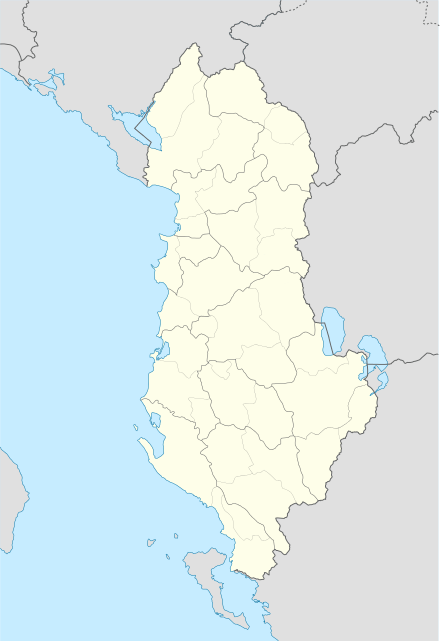Kërçisht i Sipërm
Kërçisht i Sipërm (Macedonian: Горно Крчиште/Gorno Krčište) is a village in the former Maqellarë Municipality in Dibër County in northeastern Albania. At the 2015 local government reform it became part of the municipality Dibër.[1] It is located near the Macedonian border, on the mountain Dešat.
Kërçisht i Sipërm Горно Крчиште | |
|---|---|
 Kërçisht i Sipërm | |
| Coordinates: 41°34′57″N 20°31′02″E | |
| Country | |
| County | Dibër |
| Municipality | Dibër |
| Municipal unit | Maqellarë |
| Time zone | UTC+1 (CET) |
| • Summer (DST) | UTC+2 (CEST) |
History
Of all of the local villages during the late 19th and early 20th centuries, while still under the Ottoman Empire, only Herebel and Kërçishti i Epërm were populated entirely by Bulgarian Exarchists, while the rest were populated by Muslims.[2]
Nearly 40 members of the Macedonian-Adrianopolitan Volunteer Corps were natives of the village and Kërçishti i Poshtëm.[3]
Demographics
The village today is populated by ethnic Macedonians[4] and Macedonian is spoken in the village.[5]
During the first World War occupying Austro-Hungarian forces conducted a census (1916-1918) of parts of Albania they held and of Kërçisht i Epërm its ethnic demographics they recorded 23 Albanians, 14 Bulgarians, 197 others while its religious composition was 37 Muslims and 197 Orthodox Christians.[6] Linguists Klaus Steinke and Xhelal Ylli consider the overall census results to be accurate and reflective of much of the ethnic and religious demographics of the area during that time[6], however noting that the then identity of the Orthodox Slavic speaking populace was fluid as reflected in census declarations.[7] Toward the end of the 1920s the Orthodox Slavic speaking population was located in only two villages of the Maqellarë area, Herbel and Kërçisht i Epërm while in the 1930s the population decline of Orthodox Slavophones continued.[8]
During the 2000s linguists Klaus Steinke and Xhelal Ylli seeking to corroborate villages cited in past literature as being Slavic speaking carried out fieldwork in villages of the area.[7] In Kërçisht i Epërm the village contains 200 inhabitants and 45 households of which 6 are Orthodox families with a total of 17 individuals.[8] On the eve of the collapse of communism in 1991, Kërçisht i Epërm had 110 households with 27 belonging to the Orthodox community.[8]
Use of the Macedonian language in Kërçisht i Epërm is limited and facing extinction, due to usage being confined to the family.[7] Albanian is also used in family settings especially by younger generations who have limited knowledge of Macedonian due to Albanian school influences and the demographic decline of the Slavic speaking population in the village.[7] Linguists Steinke and Ylli also noted that unlike the Gollobordë region, the villages of the Maqellarë administrative unit area do not have any Muslim Slavic speaking inhabitants.[7]
Culture
The village is home to the Church of the Holy Saviour. Established in 1232, it is a Cultural Monument of Albania.
It also contains churches dedicated to St Demetrius, St Nicholas, St Parascheva, and St Blajse.[9]
References
- Law nr. 115/2014 Archived 2015-09-24 at the Wayback Machine
- Glasnik na Institutot za nacionalna istorija (in Macedonian). 42. Institut. 1998. Retrieved July 3, 2014.
- „Македоно-одринското опълчение 1912-1913 г. Личен състав“, Главно управление на архивите, 2006
- http://mn.mk/iselenici-region/1802-Vo--Albanija-ima-vkupno-46-sela-so-cisto-etnicko--Makedonsko-naselenie
- Vidoeski, Božidar. Dijalektite na makedonskiot jazik I. Skopje: MANU. 1998.
- Steinke & Ylli 2008, p. 249. "Bin Vergleich der beiden oben erwähnten Quellen mit der von den Österreichern während des ersten Weltkrieges durchgeführten Volkszählung, die zweifellos glaubwürdig ist, da sie sich auf eine direkte Befragung der Bevölkerung in den Jahren 1916-1918 stützt, zeigt Unstimmigkeiten."; p.250. "Albaner A, Bulgaren B, Zigeuner Z, Sonstige S, Zigeuner Z, Musl. M, Orth. O; Gemeinde Maqellara: ... Kërçishti i E. 23 A, 14 B 197 S, 37 M, 197 O."
- Steinke, Klaus; Ylli, Xhelal (2008). Die slavischen Minderheiten in Albanien (SMA): Golloborda - Herbel - Kërçishti i Epërm. Teil 2. Munich: Verlag Otto Sagner. pp. 251–252. ISBN 9783866880351.CS1 maint: ref=harv (link) "Kërçishti i Epërm... Nach Angaben unserer Informanten ist der Gebrauch der Mundart sehr begrenzt und daher vom Aussterben bedroht. Man bezeichnet sie als Makedonisch und verwendet sie ausschließlich innerhaib der Familie. Doch auch in diesem Kreig wird oftmals schon Albanisch verwendet und besonders die junge Generation spricht selbst zu Hause kaum noch die Muttersprache. Das ist im wesentlichen auf den Einfluß der albanischen Schule und ferner auf den Rückgang des slavophonen Bevölkerungsanteils im Dorf zurückzuführen." p. 252. "Anders als in den Dörfern Gollobordas sind in diesem Gebiet keine Spuren von slavophonen Muslimen zu finden. Die ethnische Zugehörigkeit der kleinen orthodoxen und slavophonen Gruppe ist außerdem nicht einfach anzugeben. Bezeichnend sind in diesem Zusammenhang die Ergebnisse der 1916 von den Österreichern durchgeführten Volkszählung.... Ähnlich sind die Verhältnisse in Kërçishti i Epërm, wo von den insgesamt 234 Einwohnern 23 Albaner, 14 Bulgaren und 197 Sonstige sind und sich 37 als Muslime und 197 als Orthodoxe deklarieren. Über die ethische Identität der slavophonen Orthodoxen scheint es keine klare Vorstellung gegeben zu haben.... noch die ausführlichen Befragungen unserer Informanten sowie anderer Bewohner des Gebietes haben irgendwelche Hinweise auf weitere Orte mit slavophonen Einwohnern in diesem Bereich ergeben."
- Steinke & Ylli 2008, p. 251. "Seit Ende der 20er bis Anfang der 30er Jahre findet man nur noch Angaben für Gorno Krăčišta und Ărbele. Die demographische Entwicklung der 30er Jahre, nämlich der Rückgang des slavophonen Bevölkerungsanteils, der meist aus Orthodoxen bestand, hat sich fortgesetzt, wie die aktuell ermittelten Zahlen zeigen.... Kërçishti i Epërm hat gegenwärtig rund 45 Häuser mit ungefähr 200 Einwohnern. Darunter gibt as sechs orthodoxe Familien, drei bestehen jeweils nur noch aus einer Person und die anderen drei aus zwei, drei bzw. neun Personen. Insgesamt gibt es also 17 orthodoxe Einwohner, die slavophon sind. Es heißt, daß das Dorf vor der demokratischen Wende 1991 noch rund 110 Häuser hatte. Davon gehörten 27 den Orthodoxen."
- "Истражувач од Москва во Посета во Горно Крчишта и Ербеле" (in Macedonian). Ilinden. August 2013. Retrieved 13 July 2014.
